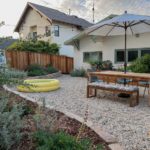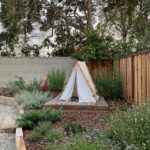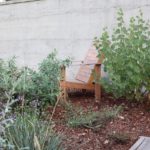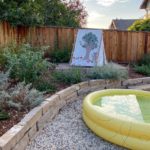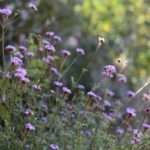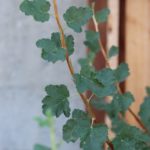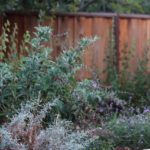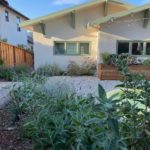Lot size: 2,500 sq. ft. back garden, 85% native
Garden Age: Garden was installed in 2020
Years on the Bringing Back the Natives Garden Tour: New this year!
Showcase Feature
This now-inviting back yard had that weedy-lot look when PlantKind first arrived on the scene. What homeowner Amelia had in mind’s eye was an attractive garden that brought nature home for her young child to explore, and for the family to enjoy together.
Fast-forward to today. The neighbors’ magnificent coast live oak anchors the space, and provides a stunning backdrop, dappled shade, a rustic ambiance, and the perfect setting for the host of keystone plants—our local natives that provide the best habitat for birds, butterflies, and other winged creatures—that were planted in its welcoming shade.
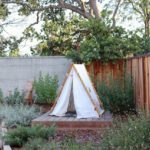 Created with children in mind play spaces, playful structures, and comfortable seating areas from which adults can see their tots, were incorporated into the design, and tucked into and between lush plantings.
Created with children in mind play spaces, playful structures, and comfortable seating areas from which adults can see their tots, were incorporated into the design, and tucked into and between lush plantings.
Purple verbena De La Mina, red fuchsia, pink currant, lavender sages brighten the garden; their blossoms offset by the greenish gray tufts of the hardy bunchgrass California fescue. The fragrant scent of sages and chaparral currant wafts on gentle breezes.
Other Garden Attractions
• No irrigation was installed; the garden is hand watered when needed.
• Permeable pebble walkways allow rainwater to recharge the aquifer—no concrete or restrictive hardscaping was used.
• Raised veggie boxes make it easy to tend and harvest produce. 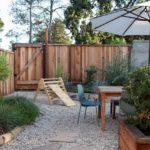
Gardening for Wildlife
A number of keystone species—our own, local ecological powerhouse plants— in this garden include:
• Vaccinium ovatum, Huckleberry
• Quercus agrifolia, Neighbor’s Live Oak
• Ribes malvaceum, Chaparral Currant
• Salvia munzii, San Diego Sage
• Salvia clevelandii, Cleveland Sage
• Arctostaphylos ‘Emerald Carpet’ Emerald Carpet Manzanita
• Rosa californica, California Wild Rose
Above are plants that butterflies and moths can lay their eggs on. Check out this chart to see why native plants are so important to wildlife!


